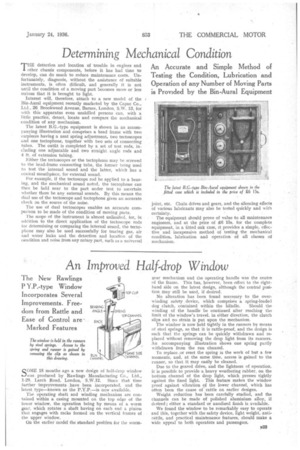Determining Mechanical Condition
Page 33

If you've noticed an error in this article please click here to report it so we can fix it.
rr HE detection and location of trouble in engines and
other chassis components, before it has had time to develop, can do much to reduce maintenance costs. Unfortunately. diagnosis, without the assistance of suitable instruments, is often difficult, and generally it is not until the condition of a moving part becomes more or less serious that it is brought to light.
Interest will, therefore, attach to a new model of the Bin-Aural equipment recently marketed by the Capac Co.. Ltd., 26, Brookwood Avenue, Barnes, London, S.W. 13, for with this apparatus even unskilled persons can, with a little practice, detect, locate and compare the mechanical condition of any mechanism.
The latest B.G.-type equipment is shown in an accompanying illustration and comprises a head frame with two earpieces having a neat spring adjustment, two tectoscopes and one tectophone, together with two sets of connecting tubes. The outfit is completed by a set of test rods, including one adjustable and two straight angle rods and 4 ft. of extension tubing.
Either the tectoscopes or the tectophone may be screwed to the head-frame connecting tube, the former being used to test the internal sound and the latter, which has a conical mouthpiece, for external sound.
For example, if the tectoscope rod be applied to a bearing, and the mechanical sound noted, the tectophone can then be held near to the part under test to ascertain whether there be any external sounds. By this means the dual use of the tectoscope and tectophone gives an accurate check on the source of the noise.
The use of dual tectoscopes enables an accurate comparison to be made of the condition of moving parts. The scope of the instrument is almost unlimited, for, in addition to the direct application of the tectoscope rods for determining or comparing the internal sound, the tectophone may also be used successfully for tracing gas, air and water leaks and the detection and location of the condition and noise from any rotary part, such as a universal
joint, etc. Chain drives and gears, and the silencing effects of various lubricants may also be tested quickly and with certainty.
The equipment should prove of value to all maintenance engineers, and at the price of £6 15s. for the complete equipment, in a fitted .oak case, it provides a simple, effective and inexpensive method of testing the mechanical condition, lubrication and operation of all classes of mechanism.




















































































